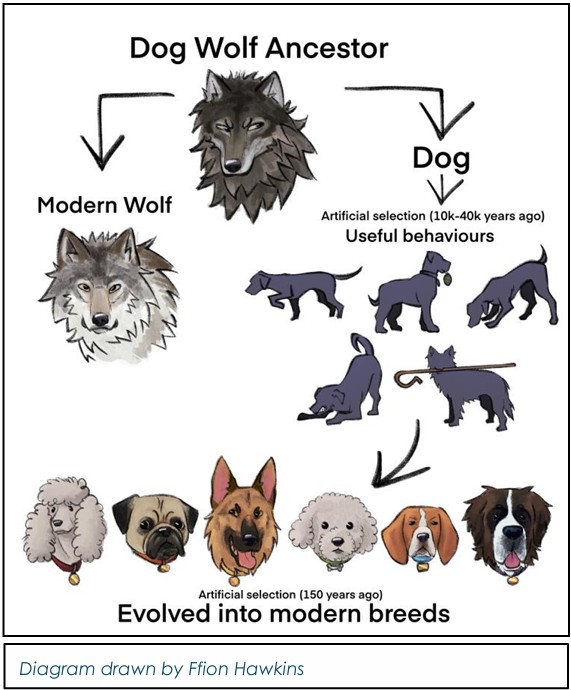CANINE CORNER WITH REBECCA HAWKINS
The History of Dogs
Whilst we can state from the offset that we know more than ever now that dogs are not mini wolves, there is no denying the origin of dogs, and so a study of wolves was inevitable. There remains a great deal that the dog inherited, certain drives and instincts, and to ignore this would be ignorant. Some believe that the domestic dog, Canis Familiaris, is the descendant of a now extinct European, dingo-like wild dog. However, no fossil of this animal has ever been found, and all genetic, behavioural and anatomic evidence firmly supports the belief that our dogs are descended from a small sub-species of wolf.


The wolf, Canis Lupus, has the same number of chromosomes as our domestic dog (seventy-eight). This differs from other canids, like jackals and foxes. For generations, those studying wolves have commented on their childlike quality, their playfulness. Adolph Murie (the first scientist to study wolves) describes how adult timber wolves, or the grey wolf, will suddenly jump out of hiding places and scare each other for no apparent reason, other than play. They bring things to each other, especially food, and will prance and parade around with sticks in their mouths. Sound familiar? This is the genetic, sensory, morphological, hormonal and evolutionary root stock of the dog, and to understand a dog's mind, it's essential to understand how we came from wolves, to the hundreds of breeds we have now.
How did domestication happen? Some scientists suggest that the
dog broke away from the wolf genetically, and as a separate subspecies tens of thousands of years ago. They also suggest that the dog chose us as apposed to us enslaving them. They loitered around the camp fire, begged for food, ate our waste and we literally couldn’t get rid of them.
As they began to adapt towards scavenging from us, the jaw shortened and the teeth became overcrowded for a time before gradually ‘catching up’ evolutionarily speaking.
In Israel a 12,000-year-old skeleton of a puppy was found in the arms of a man. Ancient carvings and pictures depicting dogs have been found from around 100,000 years ago but it’s generally accepted that dogs have been what we call ‘domesticated’, for around 20,000 years. Tracing the history and geography of both dog and human DNA shows the nomadic people brought dogs with them when they settled.
A date most generally accepted is around 14,000 years, skeletons from this period have the shortened jaw and crowded teeth, which sets them apart from wolves. We have been breeding dogs for over 1000 generations but back then dogs were more ‘types’ rather than specific breeds.
A study in 2020 by ancient dog DNA by Anderson Bergstrom et al, shows that 11,000 years ago there were at 5 distinct dog groups scattered around the world. By Roman times these six types existed:
- Villatici - house or guardian dogs
- Pastorales Pecuarii - shepherd dogs.
- Venatici - sporting dogs
- Pugnaces/Bellicosi - war dogs
- Nares Sagaces - scent hounds
- Pedicure Celeres - sight hounds
The notion that some modern day breeds such as Salukis have lineage that go all the way back to the Pharaohs is largely fantasy. There were dogs that had similar looks but they were not Salukis or Mastiffs. Some even theorise that such breeds were later created to resemble the dogs seen in ancient paintings. Most of our modern breeds actually started off life no longer than a couple of
hundred years ago. In 1870 the Kennel clubs were founded and began to keep certain types and breeds ‘pure’. Today we have over 400 different breeds all adapted by human intervention and selective breeding.